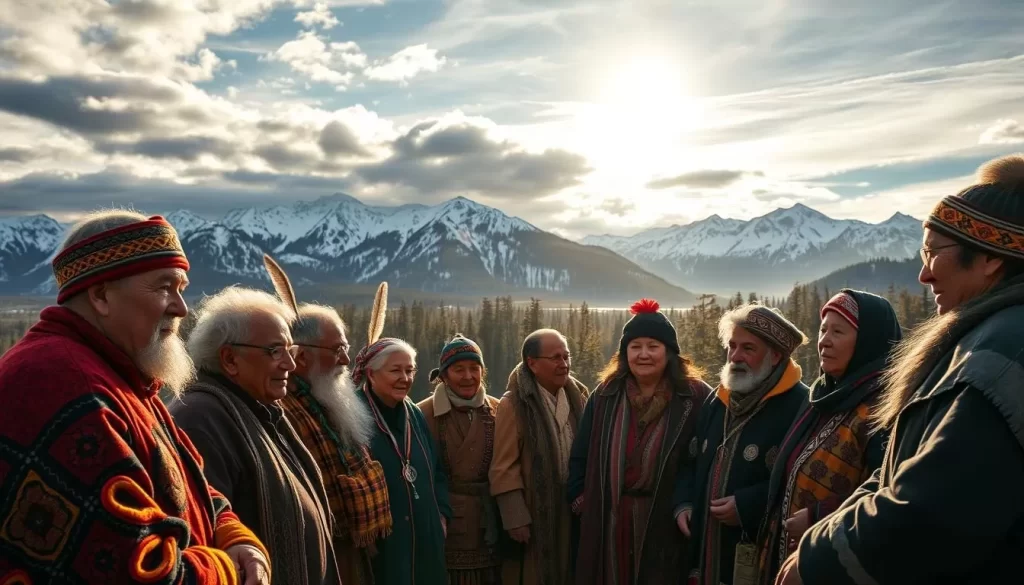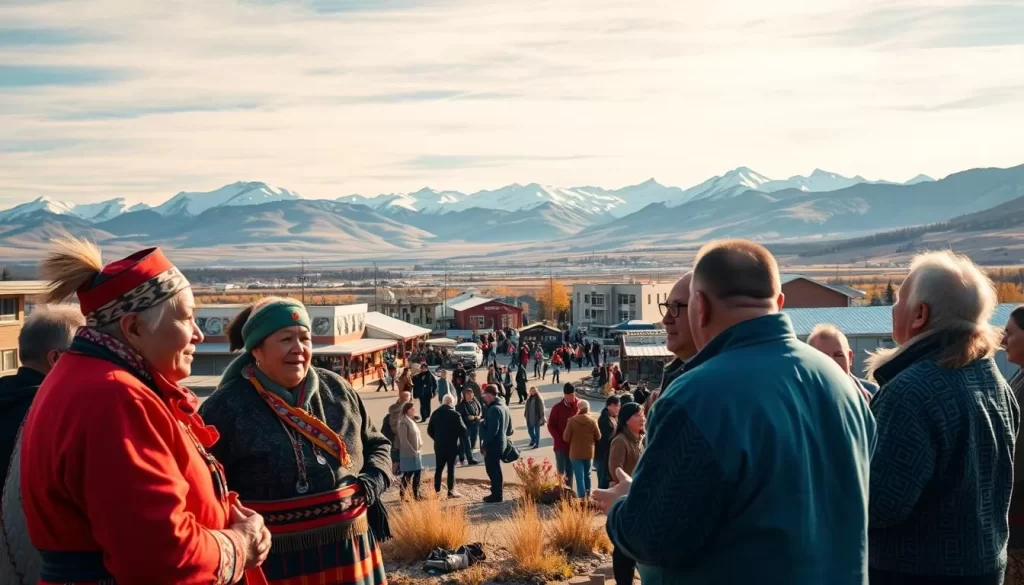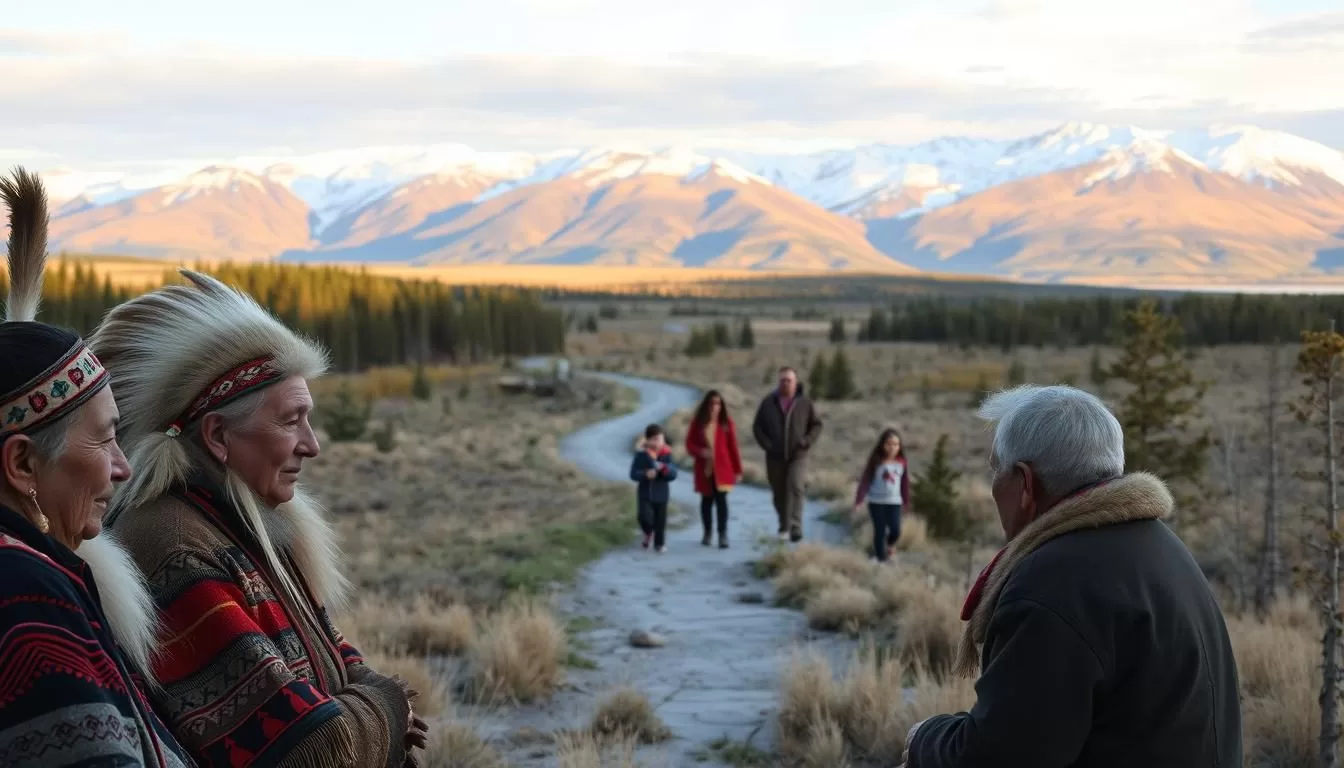As you plan your trip to Yukon, understanding the language situation will enhance your travel experience and help you connect with locals. With a population of just 44,500 people spread across a vast area, the territory has a unique cultural and linguistic environment.
English dominates as the primary language in Yukon, with 86% of the population speaking it, while French is spoken by approximately 4% of residents. The territory’s linguistic landscape is also shaped by its indigenous heritage, with several indigenous languages having deep historical roots in the region.
Understanding the official languages and the languages spoken in Yukon will help you navigate this northern Canadian territory and appreciate its cultural significance.
Language Landscape of Yukon Territory
As you explore Yukon Territory, you’ll discover a rich tapestry of languages spoken across the region. The territory’s linguistic diversity is influenced by its history, geography, and immigration patterns.
Population and Geographic Context
Yukon Territory has a unique population distribution, with a significant portion residing in the capital city, Whitehorse. The territory’s vast geography and sparse population density contribute to its distinct linguistic characteristics. With a relatively small population, Yukon has a high percentage of bilingual residents.
Linguistic Demographics Overview
The linguistic demographics of Yukon Territory reveal that English is the predominant language, spoken by 86% of the population. French is spoken by approximately 4% of the residents, contributing to the territory’s bilingualism rate of 14.2%, as per the 2021 Census. This bilingualism is a reflection of Canada’s official languages policy.
| Language Spoken | Percentage of Population |
|---|---|
| English | 86% |
| French | 4% |
| Bilingual (English & French) | 14.2% |
The language landscape in Yukon has evolved over time, influenced by historical events like the Gold Rush and contemporary immigration trends. Understanding these demographics helps you anticipate the languages you might encounter during your visit to different regions of Yukon.
English as the Predominant Language
In Yukon, English stands out as the most widely spoken language, shaping the daily interactions and official communications. As the primary language of the region, English plays a crucial role in facilitating communication among residents and between residents and government services.
Prevalence and Usage
English is the dominant language in Yukon, used in most aspects of life, including government services, education, and daily interactions. The widespread use of English is reflected in the territory’s linguistic demographics, where it is the primary language spoken at home and in public life. You’ll find that the majority of the population uses English as their first language, making it the most common language spoken in the region.
The prevalence of English is also evident in the territory’s official contexts, where it is the primary official language. Government services, public signage, and educational institutions predominantly use English, ensuring that residents and visitors can easily navigate the region.

Canadian English Characteristics
Canadian English, as spoken in Yukon, has distinct characteristics that set it apart from other forms of English. While written Canadian English is similar to British English, the spoken language has its own unique flavor, influenced by the country’s history and cultural diversity. For instance, Canadian English has adopted some French words and expressions, reflecting Canada’s bilingual heritage and the presence of English French linguistic influences.
| Characteristics | Description | Example |
|---|---|---|
| Pronunciation | Distinctive accent and pronunciation features | “about” sounding like “aboot” |
| Vocabulary | Unique terminology related to northern living and outdoor activities | Terms related to mining heritage |
| Influences | Blend of British, American, and local linguistic influences | Use of French words in everyday English |
Understanding these nuances can enhance your interactions with locals and provide insights into the cultural context of the region. As you explore Yukon, you’ll appreciate the subtle cultural differences expressed through the language, enriching your experience in this unique Canadian territory.
French Language Status in Yukon
The Yukon territory proudly showcases Canada’s bilingual heritage, with English and French playing significant roles. As a territory that is part of Canada, Yukon adheres to the country’s official bilingualism policy, ensuring that both languages are represented in various aspects of community life.
Official Bilingualism in Canada
Canada’s official bilingualism is a cornerstone of its identity, with both English and French being official languages at the federal level. This policy is reflected in Yukon, where efforts are made to accommodate both English and French-speaking populations. The 2021 Census revealed that Yukon has a 14.2% bilingual population, which is notably higher than many other provinces and territories in western Canada.
French-Speaking Communities in Yukon
While English remains the predominant language, there is a significant presence of French-speaking communities in Yukon. The territory’s commitment to bilingualism is evident in the services and resources available to francophone residents and visitors. French-speaking communities contribute to the rich cultural tapestry of Yukon, and their language is supported through various community initiatives.
French Services for Visitors
Visitors to Yukon can expect to find various services and resources available in French, particularly in major tourist attractions and visitor centers.  The official Yukon tourism website and publications also provide information in French, catering to francophone travelers. Some hospitality staff, especially in Whitehorse, may offer services in French, and certain tours and cultural experiences can be arranged in advance to accommodate French-speaking visitors.
The official Yukon tourism website and publications also provide information in French, catering to francophone travelers. Some hospitality staff, especially in Whitehorse, may offer services in French, and certain tours and cultural experiences can be arranged in advance to accommodate French-speaking visitors.
Understanding the availability of French services can greatly enhance the experience of francophone travelers in Yukon, allowing them to navigate the territory more comfortably and engage with the local culture more deeply.
Indigenous Languages of Yukon, Canada: Official and widely spoken languages
The indigenous languages of Yukon are not just a means of communication but a key to understanding the territory’s rich cultural landscape. Language is central to Yukon First Nation heritage, with the history and traditions of the many Yukon First Nations passed down through generations orally by the teachings of elders.

Athapaskan Language Family
The Athapaskan language family is prominent in Yukon, with seven languages spoken across the territory: Gwich’in, Han, Kaska, Tagish, Upper Tanana, Northern Tutchone, and Southern Tutchone. These languages are vital to the cultural identity of the First Nations communities.
Language Preservation Efforts are underway to document, teach, and revitalize these traditional languages. The Yukon Native Language Centre plays a crucial role in supporting these efforts through research, curriculum development, and training for language teachers.
Tlingit Language
Tlingit is also spoken in southwestern Yukon, reflecting the territory’s linguistic diversity. Efforts to preserve Tlingit include language learning resources and programs designed to pass the language to younger generations.
Current Status and Preservation Efforts
Indigenous language preservation is a priority for many Yukon First Nations, with various initiatives underway. Some schools in Yukon incorporate indigenous language instruction, reflecting the territory’s commitment to maintaining these vital cultural resources.
| Language | Speakers | Preservation Efforts |
|---|---|---|
| Northern Tutchone | 200 | Language classes, cultural camps |
| Southern Tutchone | 150 | Language documentation, community programs |
| Gwich’in | 100 | Language learning resources, elder-led workshops |
Understanding the challenges facing indigenous languages helps appreciate the significance of preservation efforts. Many First Nations communities view language revitalization as essential to cultural healing and strengthening identity.
Language Resources for Travelers

Exploring Yukon, Canada, becomes more immersive when you’re familiar with the local languages and have the right resources. As a traveler, having access to the right language tools can significantly enhance your experience.
Common Phrases to Know
Learning a few basic phrases in the local languages can go a long way. For English and French, common greetings and expressions are widely available. For indigenous languages, such as those from the Athapaskan family or Tlingit, you can find resources at local cultural centers.
Translation Services and Apps
For more complex interactions, consider using translation services or apps. Many modern translation apps support a wide range of languages, including some indigenous languages. These tools can be particularly helpful when communicating with locals or reading signs and menus.
Language Learning Opportunities
You’ll find opportunities to learn about indigenous languages through cultural centers and museums throughout Yukon, particularly at the Kwanlin Dün Cultural Centre in Whitehorse. The Yukon Native Language Centre also offers resources for those interested in learning more about the territory’s indigenous languages. For extended stays, language classes might be available through Yukon University, covering both French and indigenous languages.
Cultural Significance of Languages in Yukon
As you explore Yukon, you’ll discover that the territory’s languages play a vital role in its cultural heritage. The cultural significance of these languages is multifaceted, reflecting the territory’s history, geography, and the resilience of its people.
Historical Context of Language Development
The development of languages in Yukon has been shaped by its indigenous heritage and the influence of European settlers. The official languages, English and French, have played significant roles alongside the indigenous languages, contributing to the territory’s linguistic diversity.
Language and Indigenous Heritage
The indigenous languages of Yukon, belonging to the Athapaskan language family, are crucial to the cultural identity of the First Nations. Efforts to preserve and revitalize these languages are underway, reflecting their importance to the community and the territory’s cultural landscape.

Language in Modern Yukon Culture
In modern Yukon, the blend of linguistic influences is evident in its culture. You might encounter multilingual performances at arts events and festivals, celebrating the territory’s diverse linguistic heritage. The recognition of indigenous languages in public spaces and the efforts toward language revitalization underscore the evolving attitudes toward linguistic diversity.
Understanding the cultural significance of languages in Yukon enhances your appreciation of the territory’s unique identity and the complex cultural landscape you’ll encounter during your travels.
Navigating Language Differences as a Visitor
As you plan your trip to Yukon, understanding the language landscape can significantly enhance your travel experience. Yukon is a territory with a unique linguistic profile, shaped by its history, population, and cultural heritage.
English-Speaking Travelers
If you’re an English-speaking traveler, you’ll find that English is the predominant language spoken in Yukon, making it relatively easy to navigate the territory. Most services, including tourism information, are available in English.
French-Speaking Travelers
French-speaking visitors will appreciate that French is an official language of Canada, and some services in Yukon are available in French, particularly in larger centers like Whitehorse. You may find English French bilingual signage and services, especially in government offices and some tourist attractions.
International Visitors
For international visitors who speak neither English nor French, there are still ways to navigate Yukon comfortably. Consider using a translation app or carrying a pocket dictionary to help with communication. Many tourism operators and accommodations cater to international visitors, offering services in other languages. You might also find information at major tourist attractions and visitor centers available in multiple languages. Visual signage and universal symbols are widely used, helping to overcome potential language barriers.
By being aware of the language landscape and taking a few simple precautions, you can have a more enjoyable and stress-free trip to Yukon. Whether you’re an English or French speaker, or an international visitor, understanding the linguistic context will help you make the most of your time in this beautiful Canadian territory.
Conclusion
Yukon’s linguistic tapestry is rich and diverse, reflecting the territory’s complex history and cultural heritage. The territory is home to a predominantly English-speaking population, with 86% speaking English, while 4% speak French. Additionally, eight indigenous languages are spoken, including seven from the Athapasque language family and Tlingit.
As you explore Yukon, you’ll find that language is not just a means of communication but a carrier of cultural heritage, particularly for First Nations communities working to preserve their traditional languages. The territory’s linguistic diversity is a reflection of its history, from indigenous settlement to the Gold Rush era and modern Canadian bilingualism policies.
Understanding the language situation in Yukon prepares you for meaningful cultural interactions during your visit. You can appreciate the efforts to preserve indigenous languages, which highlight the importance of these cultural treasures and the commitment to maintaining Yukon’s diverse linguistic heritage for future generations.
The above is subject to change.
Check back often to TRAVEL.COM for the latest travel tips and deals.






